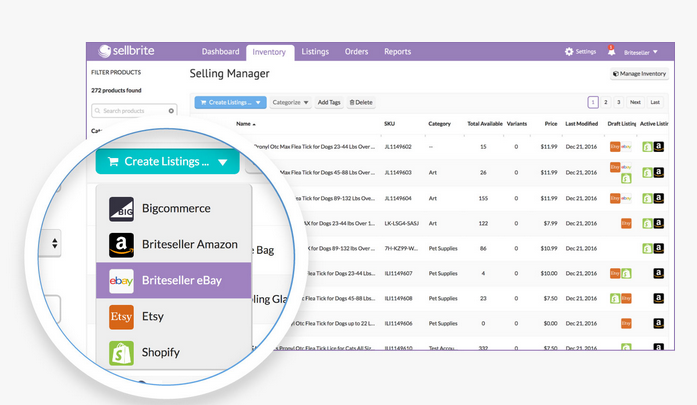55% of buyers go straight to Amazon when they shop online. Is selling on the most popular marketplace the key to maximum profits?
Not quite. Mega marketplaces, like Amazon, may offer high visibility, but other online selling platforms offer equally important advantages. A smaller marketplace, like Walmart, has less competition, making it an easier space for sellers to attract buyers. Individual web stores empower sellers to control their brand and customer experience for generating more sales.
The key ingredient to greater profits isn’t selling on the “right” venue—it’s selling on multiple venues to get the most out of each platform.
We put this theory to the test by analyzing the sales of 1,160 Sellbrite merchants. By comparing channel usage against revenue, we concluded that sellers who use 3 or more channels generate much greater sales than merchants with fewer channels. Sellers can reach more buyers and maximize sales revenue by selling on multiple channels that serve their businesses’ unique needs.
Let’s take a deep dive into our data and look at how channel usage impacts revenue.
Our methodology: Organizing sellers by inventory size
Our data analysis measures how the number of channels a merchant uses to sell online relates to their revenue. Do sellers with more channels have greater or less revenue than sellers with less channels, on average? Showing that greater channel usage leads to greater revenue would provide sellers with valuable insight—use more channels to generate more sales revenue.
To measure the sole impact of channel usage on revenue, we controlled for outside factors that could also affect revenue. We targeted the plausible confounding factor of a seller’s inventory size, which we measured by their number of offered products.
Assumptions going in
It’s easy to think that inventory size correlates with channel usage. A merchant’s breadth or depth of inventory might exceed demand for a single channel, or they may have product categories that aren’t fit for certain channels. Thus, they may be more likely to distribute their products in more places. If this were the case, we’d find that channel usage increases as inventory size increases.
Large inventory sellers also seem more likely to generate high revenue totals since they have so many items to sell. A merchant who offers the same price as another seller but has an inventory that’s ten times greater can complete more orders and earn more revenue.
Greater channel usage, then, wouldn’t necessarily be the cause of greater revenue. The increase in sales could be a result of the seller’s product count.
What we found
According to our data, this relationship between inventory size and channel usage doesn’t exist.
Sellers with inventories of all sizes use multiple channels, not just those with more products. Here’s how we broke down inventory size by product count:
In our data, Sellbrite’s smallest inventories were distributed across as many as 13 different channels. Mean channel amounts were also roughly the same, between 4 to 5, for all inventory sizes. Revenue also didn’t correlate with inventory size, as the medium-sized inventory sellers had the highest sales.
Just to be safe, we controlled for inventory size by measuring the impact of channel usage on sales for each size (small, medium, large), in addition to measuring for all sellers collectively. By isolating the factor of size, we could measure the sole impact of channel usage on revenue.
Here’s a quick breakdown of our methodology for comparing channel usage against revenue by seller inventory size:
- For each size group, calculate the average sales revenue for sellers with 1-2 channels.
- Calculate the average revenue for sellers with 3 or more channels.
- Determine the percentage of 3+ channel revenue over 1-2 channel sales.
Comparing channel usage against revenue for all sellers collectively is a bit simpler — order all sellers by their number of channels from smallest to greatest and follow steps 1 – 3.
More channels matter… by a lot
The results of our data analysis were consistent — greater channel usage is tied to significantly greater revenue. These results were true not only for each inventory size, but for all sellers collectively as well.
Sellers with <706 products
For small inventory sellers, merchants using 3 or more channels on average had 158.69% higher revenue than merchants with 1-2 channels.
Sellers with 715 – 3,156 products
For medium sellers, merchants using 3 or more channels on average had 323.53% higher revenue than merchants with 1-2 channels.
Sellers with 3,169 – 612,539 products
For large sellers, merchants using 3 or more channels on average had 3.23% higher revenue than merchants with 1-2 channels.
Sellers of all inventory sizes
For all sellers, merchants using 3 or more channels on average had 143.54% higher revenue than merchants with 1-2 channels.
Sales were greater for 3+ channel merchants across all size groups and for all sellers collectively. These results indicate that selling on multiple channels does lead to greater revenue, regardless of how many products the merchant offers.
How do I choose my channels?
Quantity is just as critical as quality when it comes to channel usage. Mulitchannel selling enables greater customer engagement and revenue when merchants mindfully select their channels — ones that meet their specific business’ needs and receive enough traffic to encourage orders.
Sellers that want to scale their business and earn maximum profits can’t ignore the major marketplaces. eBay and Amazon have high amounts of traffic and have secured consumers’ trust, so they’re optimal spaces for generating a lot of sales.
Sellers, however, shouldn’t pick marketplaces solely based on revenue. Choosing a selling venue is also tied to functionality. Here are a few advantages of smaller platforms:
- Etsy serves niche groups of sellers with unique subsets of buyers. Larger marketplaces’ audiences are more mainstream, so they can’t accommodate these niche sellers as well.
- Newegg is one of the most popular marketplaces for electronics and gaming.
- Sears is still viewed by many as a destination for home appliance and clothing.
- Walmart is one of the most traffic’d properties on the internet, yet their marketplace features fewer 3rd party sellers than Amazon or eBay.
Merchants maximize profits by choosing a variety of channels—not only high-traffic venues, but also platforms that serve the unique needs of the merchant and their customers.
Want more resources on using different channels? Check out our guides to tracking data on different selling platforms:
- Sell Smarter on Amazon: The Metrics You Need to be Tracking
- Sell Smarter on eBay: The Metrics You Need to be Tracking
- Sell Smarter on Walmart: The Metrics You Need to be Tracking
- Sell Smarter on your Online Store: The Metrics You Need to be Tracking with Google Analytics
Need help getting started?
Going multichannel can be intimidating for sellers who have only used one or two channels. Managing your inventory across multiple venues is daunting—you have to sync your listings and shipping for every channel to avoid issues like overselling and late deliveries.
Need help with your multichannel management? Speak with a product specialist at Sellbrite. Our software allows merchants to control all of their online sales channels from one central catalog for faster listing, syncing, and shipping.
Putting it all together
It doesn’t matter how small or big your ecommerce business is — merchants need to utilize multiple channels today to maximize their profits. Using three or more channels allows sellers to extend their reach to buyers and encourage more sales than if they were only on one or two venues.
Merchants can earn maximum profits by focusing on channels that are generally successful, like Amazon and eBay, and smaller channels that suit their specific business needs. Considering both types allows sellers to benefit from the busy traffic of major marketplaces and the low competitiveness on smaller channels that still attract their key buyers.















